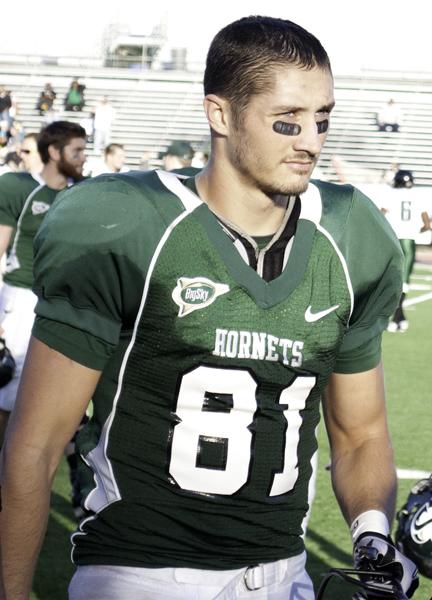Football saves wide receiver?s career and college education

sac state football deadder:Chase Deadder leads the team in receiving yards for the season with 682 yards and records 75.8 yards per game.:Steven Turner – State Hornet
November 10, 2010
Three years ago Chase Deadder was a senior in high school, carried a poor grade point average and had no plans of taking his productive high school football career to the next level.
All Division I schools shied away from giving Deadder a scholarship in large part to his poor grades, so he figured two years at a community college would best suit him.
“I never really saw myself coming to college to play football,” Deadder said. “I always thought I was just going to a junior college, so I never put my full effort into school. I was more into hanging with friends and girls.”
Those plans were abruptly changed when Sacramento State called Deadder, offering him a football scholarship.
“When I was given the opportunity to play at the Division I level at Sac State, I knew I had get after it and start studying more,” Deadder said.
Deadder played high school football in his hometown of Modesto at Central Catholic High School. After not playing his freshman season, Deadder was placed on the varsity squad as a sophomore and helped his team accumulate a 38-1 record over the next three years.
As a senior, Deadder was named all-state and first team all-Western Athletic League. Deadder accumulated 31 receptions for 625 yards and seven touchdowns during his final year.
On top of football, Deadder was also a standout in track and basketball. Deadder was named the Tri-Valley League’s best all-around player in basketball and was the MVP of the track team.
Once at Sac State, coaches decided to redshirt Deadder during his freshman season, giving him a full year to continue developing the necessary skills to become a dominant college receiver.
That proved to be a smart choice as it became evident against Eastern Washington University during his redshirt freshman season that Deadder had arrived as one the Hornets’ premier targets as receiver.
“I made a few good plays on offense and quite a few good plays on special teams,” Deadder said. “That game really made me believe I could play and belong at this level.”
During that 2008 season, Deadder led the team with an average of 17 yards per reception, ranked third on the squad with 21 catches and had 358 receiving yards.
Following Deadder’s successful first season with the Hornets, the sky seemed to be the limit for him. That is until his second season began with a serious setback that many feared would negatively affect the rest of his college career.
Deadder was participating in a 7v7 scrimmage near the end of practice when the play was called out for him to run a fade route into the endzone.
“We decided to do one more play and it was a fade route, so I ran the fade, jumped into the air, caught the ball and our safety at the time accidentally collided with me,” Deadder said. “The impact knocked me to the ground and just snapped my collarbone.”
Just like that, Deadder’s season was over before it even began.
Despite the bad news that his injury required surgery, Deadder choose to use the unfortunate situation as motivation in his fight to become a dominant football player.
“The injury made me want to work harder and come back stronger,” Deadder said. “It really made me think about how much I missed the game and how much I appreciate playing it.”
Deadder has carried that extra motivation from his injury with him into this season. He leads the team with 682 receiving yards and has three touchdowns.
Head coach Marshall Sperbeck has been pleasantly surprised with Deadder’s ability to bounce back from such a serious injury.
“He hasn’t had any problems coming back from injury,” Sperbeck said. “Early in this season, he had to shake off a little rust. But ever since he got through that, he has been great.”
One attribute Deadder uses to his advantage is his size. At 6-foot-4, 220-pounds, Deadder is among the biggest receivers in the Big Sky Conference.
“His physical presence and his speed are probably the top two things he brings to the offense,” Sperbeck said. “He is able to get open with his speed and it’s hard for defenders to cover him because of his height. With him being 6’4 we try to get him isolated in man-to-man situations and hopefully get him a chance to go up and get the ball against a 5’9 defensive back. That usually will work out in our favor.”
Sac State quarterback Jeff Fleming said having a player of Deadder’s caliber makes his job a lot easier and the offense more threatening to opposing defenses.
“When you have a player like Chase, you just need to find a way to get the ball in his hands,” Fleming said. “Whether it’s handing it to him, throwing it to him down the field or running short routes to get him the ball quickly. Once he has the ball, his size and speed allows him to do whatever he wants with it.”
Coming off the Hornets’ big win against No. 25-ranked Northern Arizona University, Deadder is confident that his team will finish the 2010 season strong.
“I believe we are going to win our last three games,” Deadder said. “They are all good opponents, but I believe we are going to be far ahead of them. We just need to stay on track, keep pounding them on offense and keep getting turnovers from our defense.”
Brad Schmidt can be reached at [email protected]




























































































































